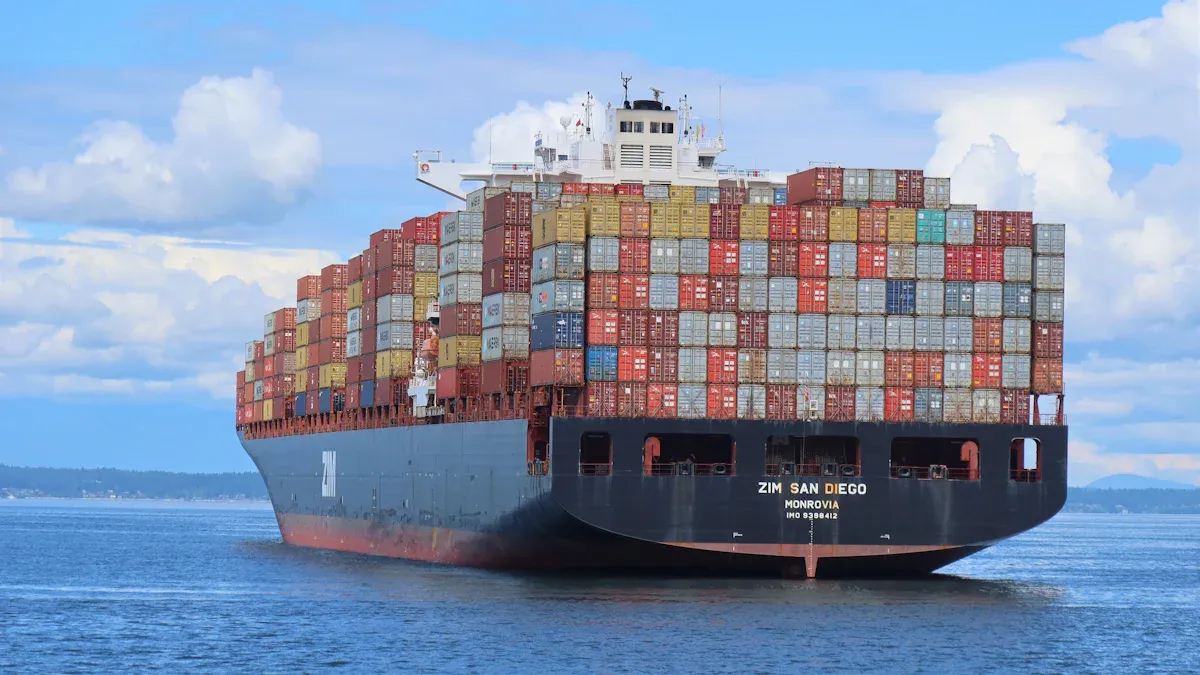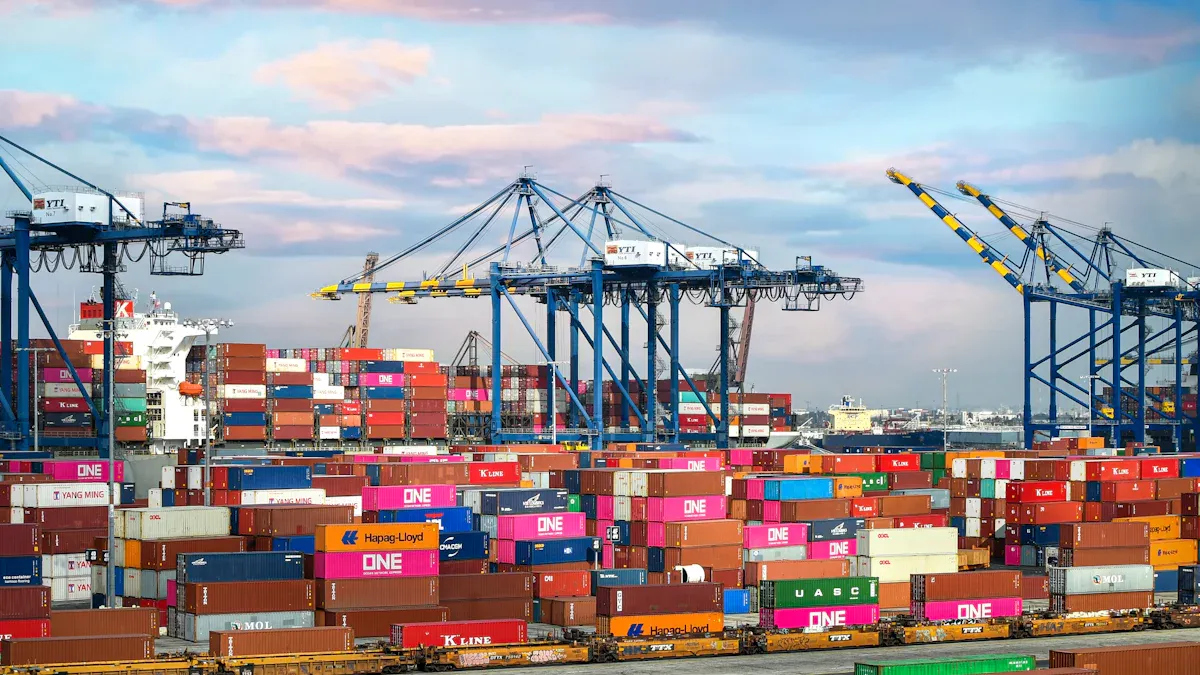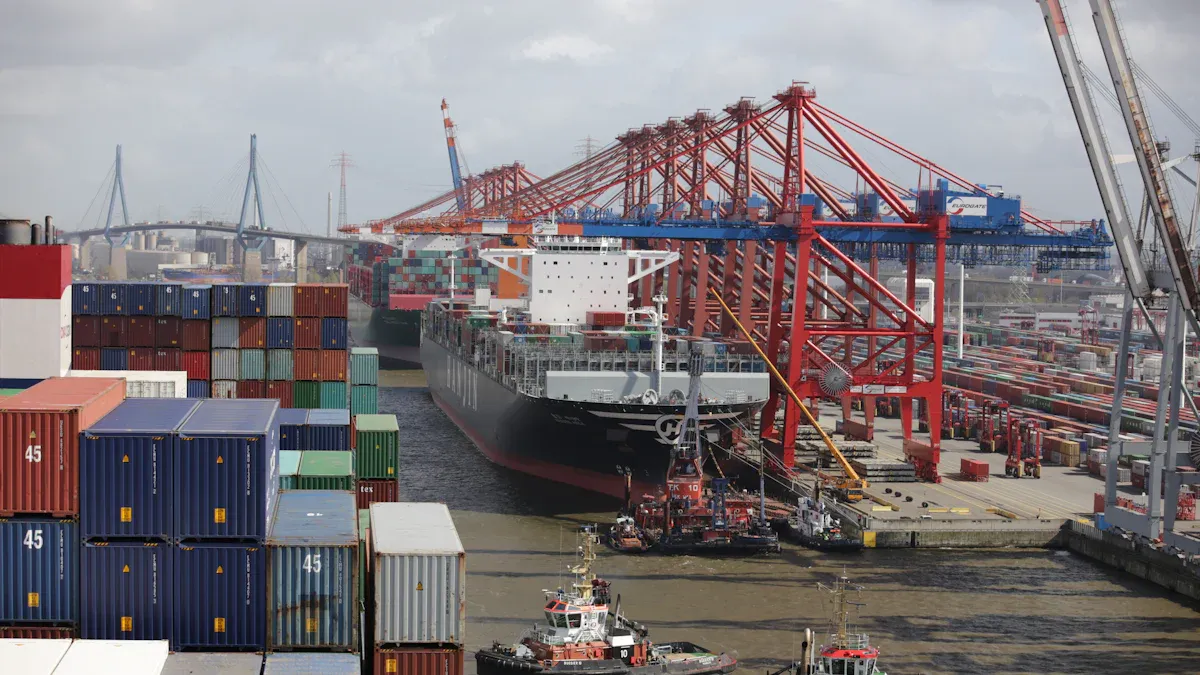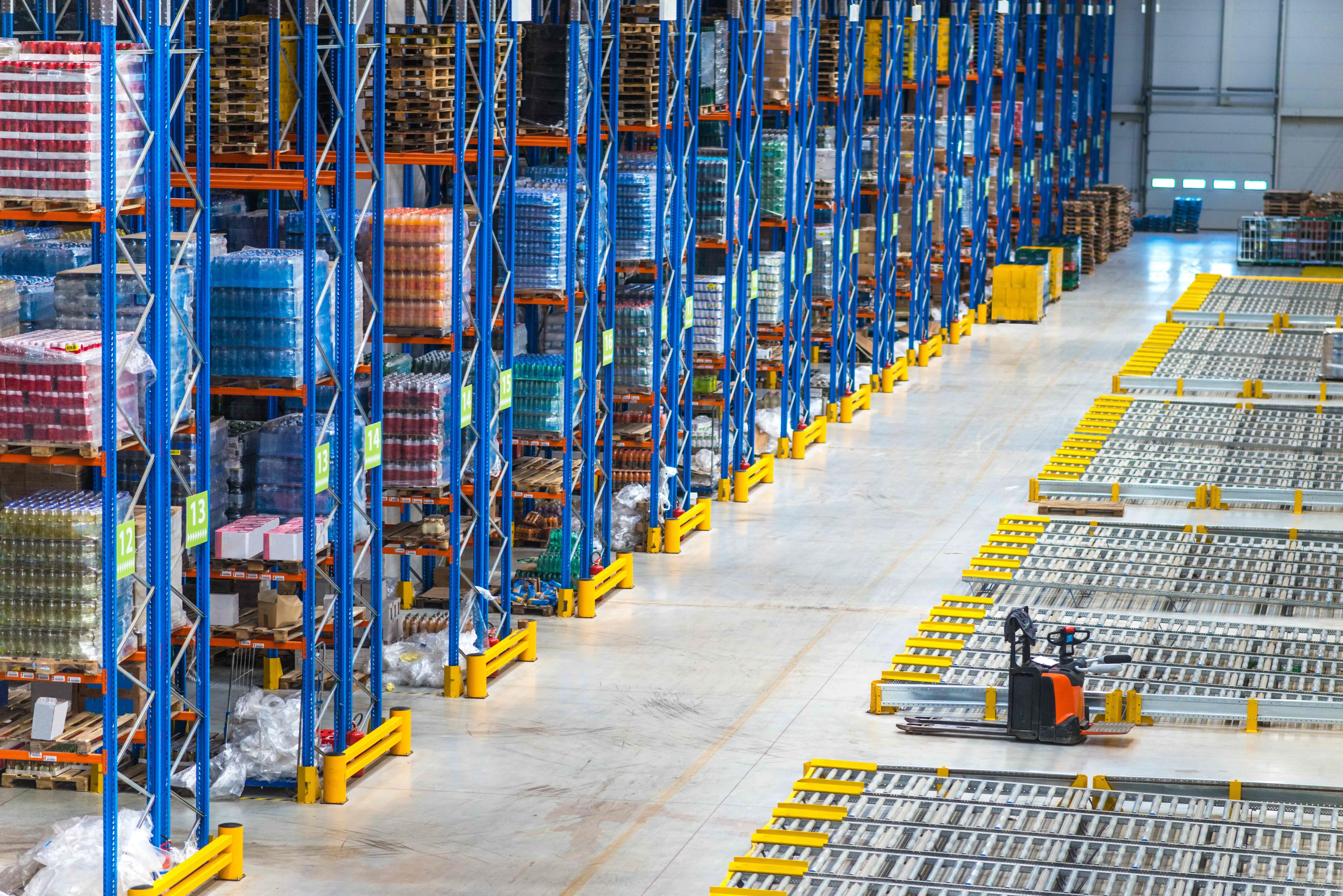International Freight Shipping What Businesses Need to Know

When you ship goods across borders, you engage in international freight shipping. This process moves products between countries and supports global business growth.
Over 80% of international merchandise trade volume moves by sea, showing the strength of maritime freight shipping.
In 2024, container volumes stabilized in Europe and America, while Asia, especially China, increased exports using containers and bulk dry vessels.
Geopolitical events can change routes; after attacks in late 2024, Suez Canal container traffic halved from January 2024 to January 2025.
The number and capacity of vessels reflect global shipping trends.
Real-time tracking now uses AIS data for fast updates in international shipping.
Efficient logistics play a vital role in international freight shipping. Studies show that better logistics service, customs clearance, and infrastructure can increase trade volumes and lower costs. When you understand freight shipping, you make smarter choices for shipping internationally, improve your supply chain, and help your business grow in international markets.
Key Takeaways
International freight shipping moves goods across countries and supports global business growth using sea, air, rail, and land transport.
Following key shipping steps carefully—like packing, customs clearance, and choosing the right transport mode—helps avoid delays and extra costs.
Choosing reliable shipping providers and using technology like real-time tracking improves efficiency, saves money, and keeps customers satisfied.
International Freight Shipping Overview

What Is International Freight?
International freight shipping moves goods between countries using different transportation modes. You use this process when your business needs to send products across borders, whether by sea, air, rail, or land. International freight plays a vital role in the global economy. It supports trade, manufacturing, and the delivery of goods to customers around the world.
You can see the impact of international freight shipping in many ways. Shipping transports about 11 billion tons of goods each year, which is nearly 1.5 tons for every person on Earth. International shipping carries about 90% of world trade. Over 50,000 merchant ships operate globally, moving everything from raw materials to finished products. This system allows you to access new markets, store and transport resources, and improve your customer experience.
International freight shipping enables your business to:
Establish a presence in international markets.
Store and move equipment, inventory, and materials.
Create added value and save costs.
Improve customer satisfaction and brand standards.
Support manufacturing with better efficiency and production rates.
Benefit from technology like AI, robotics, GPS, and blockchain.
Grow with e-commerce and online shopping.
Adopt sustainable practices that lower environmental impact and fuel costs.
The industry has changed a lot in the past decade. Long-term ocean freight container shipping rates have stayed flat, but short-term spot rates have gone up and down. These changes happen because of inventory adjustments, geopolitical risks, and supply chain disruptions. For example, spot rates on Far East trade routes have increased, while some routes between North Europe and the US East Coast have dropped by 3.3% since April 1. These trends show how international freight shipping responds to both demand and supply changes.
Here is a table that highlights key facts about international freight shipping today:
Aspect | Details |
|---|---|
Number of Shipping Containers | Approximately 65 million containers globally |
Freight Share by Container Ships | About 16% of total freight weight globally, but over 60% of total freight value |
Expected Growth Rate | 2-5% annual growth in container numbers due to expanding global trade |
Importance of Containerization | Key for transporting high-value goods efficiently; accounts for over 60% of trade value |
Technological Trends | Automation, AI, blockchain, big data improving operations and transparency |
Sustainability Efforts | Cleaner fuels (natural gas, biofuels, hydrogen), energy efficiency, decarbonization initiatives |
Visibility and Transparency | Real-time tracking and improved collaboration among stakeholders |
Industry Challenges and Trends | Evolving trade routes, geopolitical impacts, and digital transformation |
You can see that international freight shipping is not just about moving goods. It is about using technology, managing costs, and meeting global demand. JUSDA, as a global supply chain leader, helps you navigate these challenges. JUSDA offers solutions that use automation, AI, and real-time tracking to make your shipping more efficient and transparent.
Key Steps in Freight Shipping
When you ship goods internationally, you follow a series of important steps. Each step affects how quickly and safely your products reach their destination. Understanding these steps helps you avoid delays and extra costs.
Pre-Shipment Preparations
You start by inspecting, packing, and labeling your goods. You must follow regulations and note any special handling needs. Good preparation prevents delays and compliance problems.Export Haulage
You move your goods from the factory or warehouse to the port, rail terminal, or airport. Efficient timing and coordination here are crucial. This step sets the pace for the rest of the shipping process.Export Customs Clearance
You ensure your shipment meets all export regulations. You prepare and verify documents, work with customs brokers, and pay any duties. Proper customs clearance avoids unexpected costs and delays.Freight Booking & Documentation
You book space with carriers and obtain key documents like the Bill of Lading and Delivery Order. Accurate paperwork ensures smooth customs clearance and shipment processing.Loading and Freight Transportation
You select the best mode of transport—sea, air, rail, or land. You load your goods safely and manage logistics. Choosing the right mode and consolidating freight can save you time and money.Import Customs Clearance
When your goods arrive, you comply with the destination country’s rules. You secure import licenses, pay tariffs, and verify documents. Fast customs clearance keeps your delivery on schedule.Import Haulage
You transport your goods from the port or terminal to the final destination. Reliable last-mile delivery ensures customer satisfaction and successful shipping.
Tip: Each step in the freight shipping process requires attention to detail. Missing documents or poor coordination can cause delays and extra costs.
JUSDA supports you at every stage of international freight shipping. The company uses advanced technology and a global network to streamline each step. JUSDA’s expertise in freight forwarding services and freight forwarding helps you manage documentation, customs, and logistics with confidence.
International freight shipping involves many moving parts. You need to plan, coordinate, and track your shipments from start to finish. By understanding the process and working with experienced providers like JUSDA, you can make shipping internationally smoother and more cost-effective.
Freight Shipping Services and Methods

Sea Freight and Air Freight
You have many options for freight shipping. Sea freight is the most common choice for large shipments. You can move huge amounts of goods in shipping containers across the world. Sea freight is cost-effective for bulk items and offers high capacity. However, shipping by sea takes longer and can face delays from weather or port congestion. Air freight is the fastest way to ship goods. You can use air freight for urgent, high-value, or perishable items. Air freight shipping costs more and has strict weight and size limits. You pay a premium for speed and reliability.
Freight Mode | Cost Effectiveness | Speed | Capacity | Environmental Impact | Ideal Use Cases |
|---|---|---|---|---|---|
Sea Freight | Most cost-effective for large, bulk shipments | Slowest | Very high | More efficient per ton | Bulk goods, flexible schedules |
Air Freight | Most expensive | Fastest | Limited | Highest emissions | Urgent, high-value goods |
Rail and Land Freight Solutions
Rail freight shipping gives you a balance between cost and speed. You can move heavy or bulk goods faster than sea freight and at a lower cost than air freight. Rail freight shipping is also better for the environment. In the UK, rail freight removes millions of lorry journeys each year and cuts emissions by 76% per ton compared to road freight shipping. Land freight shipping, such as trucks, works well for short distances and door-to-door delivery. You get flexibility and reach, but land freight shipping has less capacity and higher emissions than rail.

JUSDA and China-Europe Express Rail
JUSDA’s China-Europe Express Rail offers a smart solution for your freight shipping needs. You get delivery in 15-20 days from China to Europe, which is much faster than sea freight shipping and much cheaper than air freight shipping. This service uses advanced pricing and strong alliances to keep costs low and profits high. You can ship electronics, clothing, and medical supplies in containers with reliable customs support. When you choose a freight shipping method, think about your budget, delivery time, cargo type, and destination. JUSDA helps you match the right freight shipping services to your business needs.
Cost, Timeframes, and Choosing Solutions
Factors Affecting International Freight Costs
When you plan international freight shipping, you need to understand what drives your costs. The size and weight of your shipment matter most. Heavier or bulkier cargo uses more space and fuel, so you pay more. The distance between your origin and destination also increases costs. Longer routes mean more fuel, labor, and complex logistics. The mode of freight shipping you choose—sea freight, air, rail, or land—affects both cost and speed. Sea freight is cost-effective for large shipments, but air freight is faster and more expensive.
You also face extra charges. These include documentation fees, insurance, customs clearance, and surcharges like congestion or peak season fees. For example, during the COVID-19 pandemic, port congestion and space shortages caused freight rates to spike. Carriers sometimes keep congestion high to raise profits, which can delay your shipments and increase costs. You can manage costs by consolidating shipments, optimizing packaging, and choosing efficient routes.
Cost Factor | Impact on Shipping Cost and Time |
|---|---|
Shipment Size/Weight | Higher charges for larger/heavier loads |
Distance | Increases fuel and labor costs |
Mode of Transport | Sea freight is cheapest, air is fastest |
Documentation | Fees for paperwork and customs |
Insurance | Varies by coverage and cargo value |
Surcharges | Congestion, peak season, and other fees |
Selecting Freight Shipping Providers
Choosing the right transportation providers is key for reliable freight shipping. You should check each provider’s safety record, experience, and insurance. Make sure their network covers your shipping destinations. Look for providers with strong customer service and on-time delivery. Reliable sea freight and other freight shipping services help you avoid delays and extra costs.
Follow these steps to select the best transportation providers:
Check experience with your cargo type.
Confirm licensing and insurance.
Assess equipment and fleet condition.
Match network coverage to your needs.
Prioritize reliability and on-time delivery.
Ensure transparent pricing.
Evaluate customer service and communication.
Consider environmental practices.
Read reviews and references.
You can use digital platforms to track performance and manage documentation. JUSDA’s technology-driven transportation solutions help you reduce risks and improve efficiency in international freight shipping.

JUSDA Solutions
To provide you with professional solutions and quotations.
You need to choose the right freight shipping method and provider to improve your shipping results. Studies show that smart shipping choices help you save money and keep customers happy. You can talk to experts or try JUSDA’s China-Europe Express Rail for better freight shipping. Use technology to track shipping and boost efficiency.
See Also
Discover The Latest Trends In Sea Freight Logistics 2024
Comprehensive Insights Into Leading Global Logistics Firms
Top Reasons To Join The Best Logistics Webinars Today
In-Depth Look At The Future Of LTL Freight Shipping
New Strategies For Managing Supplier Relations In Cross-Border E-commerce
